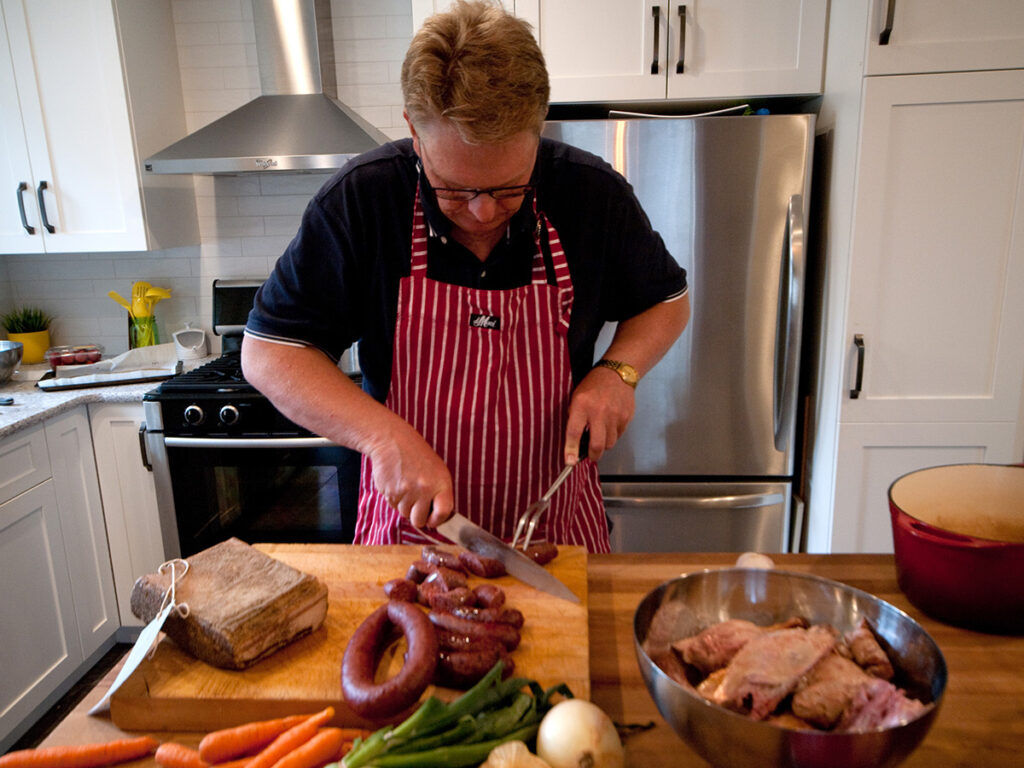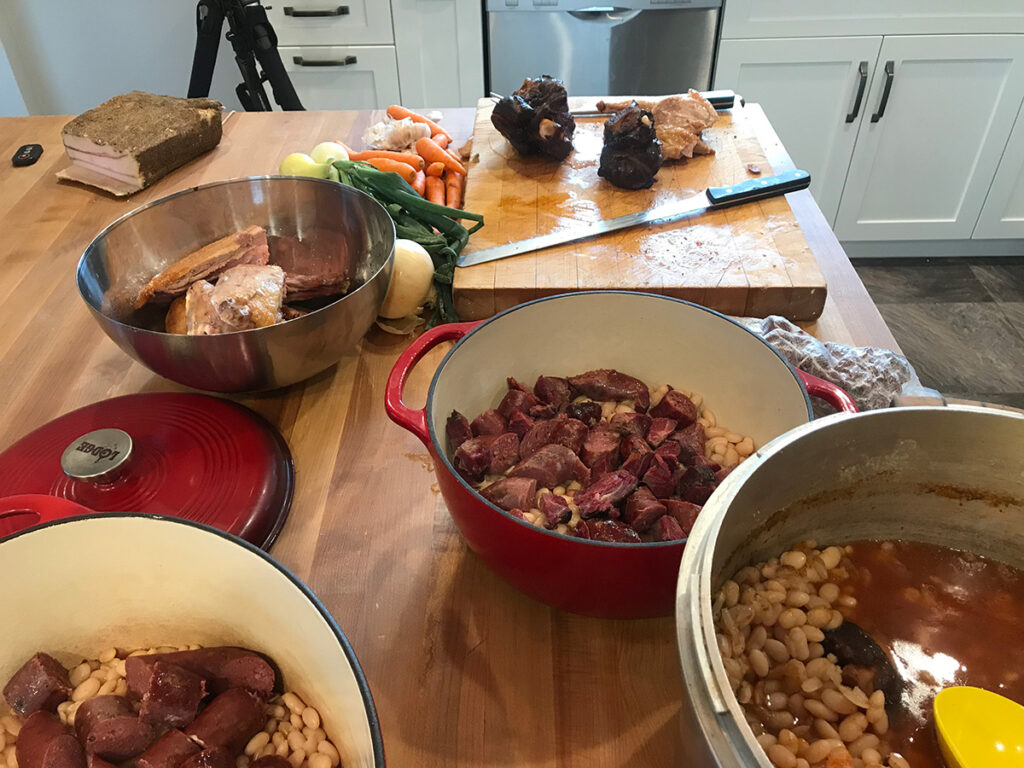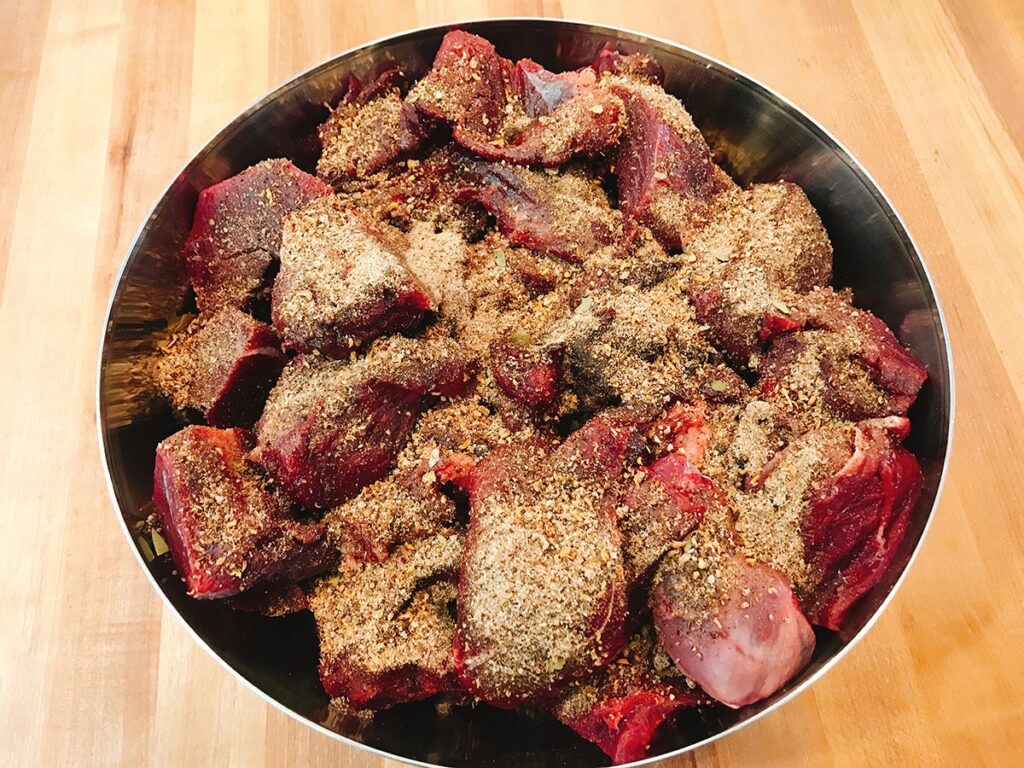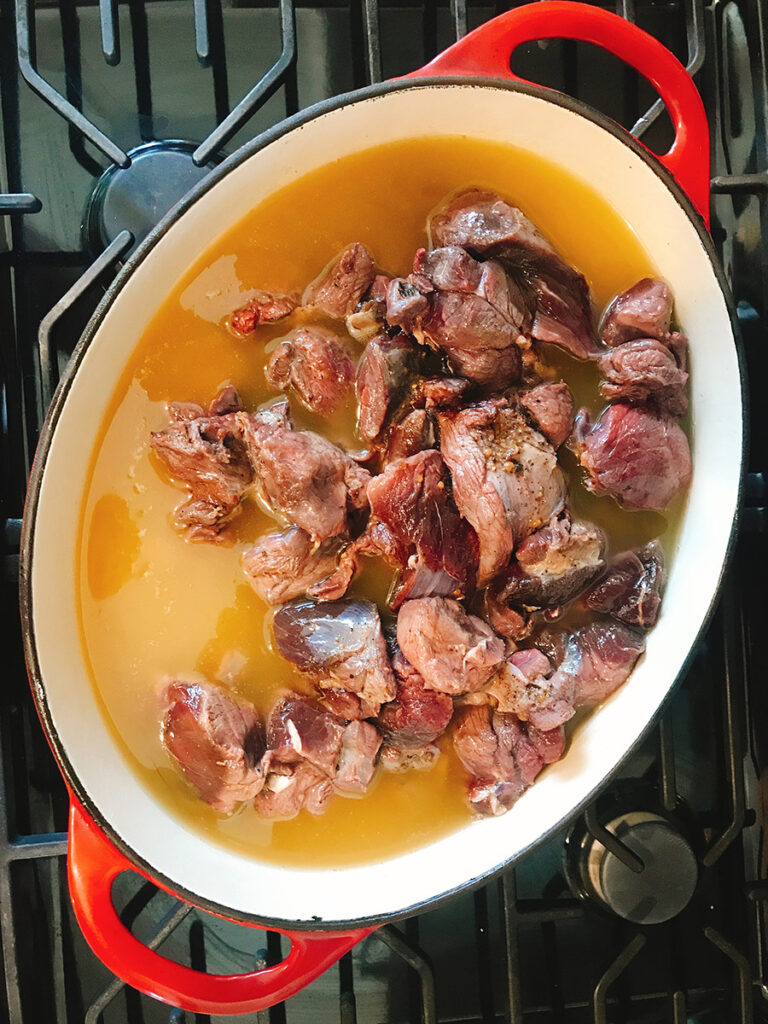At CarnivoreWeb.com, we independently review products and outfitters. However, we may earn a commission when you purchase products through links on our site. Read our affiliate policy. Read about how we test products.
Confit is an ancient process that results in a perfect, decadent taste. Here we look at how to make it with black bear.
The one culinary method that most affects my wild game preparation is confit. Now, confit sounds like a fancy French word, but don’t be fooled; the process was invented hundreds of years ago by French farmers dealing with the urgent necessity of preserving meat without refrigeration. Meats were salted, covered in fat, and simmered for several hours, later to be cooled and stored in clay crocks — the meat covered in a layer of protective fat was preserved for a year or longer. It’s no longer a necessity to confit, but we often still do because of the flavor, and that rich, unctuous mouth-feel and the tender bite of perfectly salted meat slowly simmered in fat. My pantry includes confit black bear, hare, rabbit, wild goose, duck, and mule deer.
Confit Defined
While Kate Hill was born in Hawaii, she chooses to live in the south of France, where she operates a vacation home and group culinary instruction. She’s an author, cook, French travel guide, hostess, and expert in the art and science of confit.
Hill said, “You’re right about the word confit. Anytime you say a French word, it sounds fancy, but actually, it’s from the same base word confrere, the verb to confit, which means to preserve. You have jams, jellies, and preserves — confitures. These are the words that mean to preserve. It could be sweet things like jams and jellies, or it could primarily be meat cooked in, and preserved in, its fat. Confit is both a process and a product that started long before refrigeration. In the warm regions of Southern Europe, confit was a way to preserve the bounty of the winter slaughter, whether it was a pig, ducks or geese, game, or other animals. These items would be preserved in the fat in which they were cooked. Meats were salted first and then cooked in the fat and preserved in the fat without air. It was a way to keep the food so people wouldn’t starve and not waste any food. This is the confit I learned about when I came to France, because this area is the primary duck and goose producing region of France.”

Hill explained further, “The confit process starts with a freshly slaughtered animal. In Gascony, the top-tier confit are the best products that come from people who are raising ducks. They slaughter the ducks in the morning, and immediately while the carcasses are warm, they salt them. I usually get my ducks from a neighbor’s farm and pick them up the morning of the slaughter. The last time in December, I got four of these big ducks. And then I came home and butchered the carcasses. These four ducks ended up with probably 40 pounds of confit. I’ve got a duck that weighs 6 kilos — that’s like 13½ pounds. By the time I’ve taken everything off the carcass, there’s not much waste in the duck. So I’m going to end up with close to 10 pounds of meat from each bird. That is an excellent meat ratio.”
Published Guides to Confit
Michael Ruhlman and Brian Polcyn have written two books that cover the art and science of confit. Ruhlman’s research took him to the south of France to work with Hill to explore the process of confit and collect material for writing the books. Ruhlman said, “In about 2004, I realized that my love of duck confit — that rich, fatty meat that’s poached in fat and then stored in that fat and when you pull it out of the fat, heat it up and crisp the skin — was probably the best thing you could eat. But what got to me is that we didn’t create this so we could please ourselves — we made this so we can stay alive. And how can something that is born of such dire necessity result and continue to deliver this outstanding food that we have in restaurants and now make regularly at home? I thought I’ve got to explore this. What other things did we do to stay alive that we maintain and continue to do just because it’s so delicious?”

Gascony, in southwestern France, is the home of duck confit. Hill said she lives with people who make confit for preservation, and they won’t eat last year’s confit; they’ll eat confit made two years ago and save this year’s so they know they have enough for next year. If it’s properly preserved, it can last for three years or more. Indeed, it’s safe; it’s a matter of developing the taste and flavor.
Ruhlman said, “My percentage-wise rule of thumb is anything that you’re going to eat hot, like confit, keep it around 2 percent salt. If you’re preparing something cold like prosciutto, it can go as high as 3 percent, but that’s getting salty. So between 2 and 3 percent by weight is the correct ratio. I would recommend that people at home use cast-iron enamel to prepare confit. That’s what I would do in the fall. I would pack 12 duck legs into a big Dutch oven and cover them with either duck fat or olive oil. After I’d cured the duck legs with salt and cooked them in that pot, I then transfer them to a smaller vessel to put in the fridge. I would eat that confit all year long. Olive oil is a great option for confit, and, of course, pig fat and duck fat are great.”

Rules for Game Confit
Most game can be confit’d too. Pork fat is a great addition to meats like bear and hare for confit. Brian Polcyn co-authored two books with Ruhlman. The first book, Charcuterie, deals with all kinds of French sausage and confit. Their most recent book Pate, Confit and Rillettes tackles confit again.
Polcyn said about game like bear, “More importantly, if using game like bear there’s more potential for risk. So if you have a doubt, cook it another hour. Cook it; you’re not going to hurt it by overcooking it. Watch the temperature; keep it below 180 degrees F, and cook it until it’s done.”
Black Bear Confit Recipe
French farmers developed the confit process to preserve meats before we had refrigerators and used the process to cure their fall-slaughtered ducks for the months ahead. The exact process works well with bear too. There are a few steps to the process, but the delicious outcome is worth it. Season cubes of bear meat with salt and spices, “cure” for 24 to 48 hours, rinse, dry, cover in fat, and simmer at 190 degrees F for four to six hours in the oven. It’ll change your mind about bear.
Measures
The salt and curing salts ratio to meat and liquid is critical for a safe cure and correct flavor. Buy and use a gram scale to ensure an accurate measurement of ingredients. Keep a careful record of ingredient weights by gram for every batch of confit, cure, and sausage you make. Then, you can review your notes about how the product tastes and make educated adjustments based on objective data.
Food Safety
Bears are omnivores. Trichinellosis is a risk that can be managed by wearing gloves while handling bear carcasses and butchering. The USDA recommends cooking bear meat to 145 degrees F and holding for at least 3 minutes to kill trichinella. Polcyn’s recommendation of cooking at a sustained 180 degrees F takes care of this concern.

Ingredients
- 11 pounds (5 kilos) of bear meat cut in 2-inch cubes (If you don’t have an excellent fat bear, go ahead and substitute fresh pork picnic shoulder. It’ll give a perfect result too.)
- 2 ounces (60 grams) fine salt
- 6 grams sodium nitrite cure (use a gram scale for these salts and spices)
- 8 grams black peppercorns
- 13 grams Szechuan peppercorns
- 8 bay leaves crushed
- 3 grams ajowan seeds (substitute 6 grams of thyme if you can’t find ajowan)
- 2 quarts or about 4 pounds of rendered bear or pork lard, duck fat, or olive oil or a combination of all three
Method
- Trim bear shoulder and leg meat into 2-inch cubes; refrigerate.
- Mix dried spices and pulverize in the spice mill or coffee grinder.
- Add salts and mix well.
- Sprinkle spice and salt mixture over the meat chunks and toss well to coat meat cubes.
- Cover and refrigerate for two days.
- After 24 hours, remove and toss the cubes to ensure spices and salt are well distributed. Return to the fridge.
- After 48 hours, remove, rinse with cold water to wash off spice, dry with paper towels.
- Place bear cubes in Dutch over or deep (turkey) roaster.
- Melt fat and pour over meat to cover with fat.
- Place over medium heat on stove and heat, occasionally stir until the fat starts to bubble.
- Preheat the oven to 190 degrees F.
- Place the roaster in the oven, uncovered.
- Remove and stir every hour or so.
- Remove and test a piece of meat for tenderness at 4 hours. Confit will take 4 to 6 hours to fully cook.
- Remove from oven when meat is desired tenderness. Drain, cool, vacuum seal package.
- Keep and refrigerate or freeze fat for the next confit.
The guys I hunt with try to eat some of whatever we took last year while we hunt for what we’re taking this year. It seems like a luxury to do this. These unique products fit into recipes like jambalaya, paella, baked beans, and French Cassoulet. Every hunting trip includes at least one meal of bear.
To be clear, this is a lot of work. But the rewards multiply with curing and smoking your own meat. The taste of bear might surprise you. This process will give you bragging rights with your buddies.

Sources
Kate Hill: relaisdecamont.com
- Hill, Kate. Cassoulet, A French Obsession. Napa, California: Rancho Gordo New World Specialty Food, 2015.
- Ruhlman, Michael, and Brian Polcyn. Charcuterie, the Craft of Salting Smoking and Curing. New York: W. W. Norton 2013, 2005.
- Ruhlman, Michael, and Brian Polcyn. Pate, Confit and Rillettes, Recipes from the Craft of Charcuterie. New York: W. W. Norton 2019.
Editor’s Note: This article originally appeared in Carnivore Magazine Issue 9.
More Great Wild Game Recipes
- Venison Philly Cheesesteak
- Sous Vide Wild Boar Shank
- Elk Jerky
- Easter Bear by Hank Shaw
- Mediterranean Spiced Ground Venison Kofta
Why You Can Trust CARNIVORE
Since its launch, CarnivoreWeb.com has been a trusted authority on hunting, fishing and wild food, delivering expert insight for outdoorsmen who live the field-to-table lifestyle. More than a hunting and fishing site, CarnivoreWeb.com covers the full spectrum of the modern outdoors—from rifles, bows, and fishing gear to cooking, conservation and adventure.
Our contributors are drawn from across the hunting and angling world, including seasoned guides, lifelong hunters, competitive shooters and outdoor writers with decades of field experience. Every review, article and feature is built on firsthand testing, deep research, and an unwavering commitment to accuracy.
Commitment to Journalistic Principles
At CarnivoreWeb.com, upholding journalistic integrity is our top priority. We follow strict editorial standards to ensure all content is accurate, transparent, and unbiased. Our editors and writers operate independently, free from outside influence, advertisers or stakeholders. We adhere to established journalistic codes of ethics, holding ourselves accountable for the information we publish, correcting errors when they occur and disclosing any potential conflicts of interest.
This commitment ensures that our readers can trust CarnivoreWeb.com to provide reliable, honest coverage that helps them make informed decisions—whether selecting gear, honing outdoor skills or preparing wild game.
Find out more about our Editorial Standards and Evaluation Process


